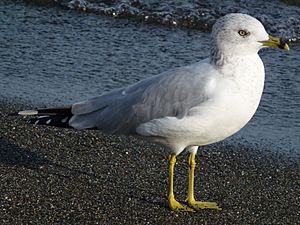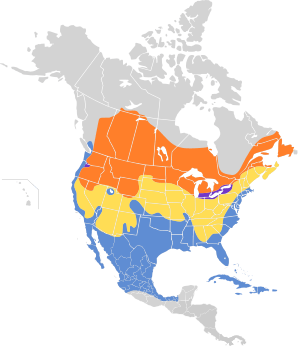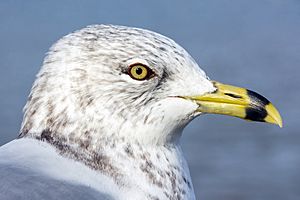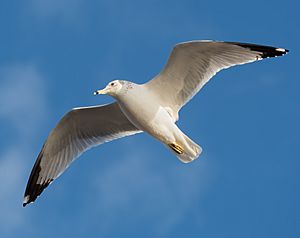Ring-billed gull facts for kids
Quick facts for kids Ring-billed gull |
|
|---|---|
 |
|
| Adult breeding | |
 |
|
| Non-breeding adult | |
| Conservation status | |
| Scientific classification | |
 |
The ring-billed gull (Larus delawarensis) is a common medium-sized gull found across North America. Its name comes from the dark ring on its beak. The word Larus is Latin for a large seabird, and delawarensis refers to the Delaware River.
Contents
What Does It Look Like?
Ring-billed gulls have white heads, necks, and undersides. Their backs and wings are a shiny silver-gray. They have bright yellow legs and a yellow beak with a clear dark ring around it. Their eyes are yellow with red rings.
These gulls grow to be about 17 to 21 inches (43-54 cm) long. They weigh between 10.6 and 24.7 ounces (300-700 grams). Their wings can spread wide, from 41 to 46 inches (105-117 cm).
It takes three years for a young gull to get its full adult colors. Its look changes a bit each fall after it sheds its old feathers. A ring-billed gull that lives to adulthood usually lives for about 11 years.
Where Do They Live?
Ring-billed gulls like to live near water, such as lakes, rivers, or the coast. They are found in Canada and the northern United States. They build their nests on the ground, often on islands, in large groups called colonies.
These birds often return to the same nesting spot year after year. You can often see many ring-billed gulls in American parking lots. They gather there in big groups, looking for food. Sometimes, they even take over areas from other, less pushy birds.
Traveling South
Ring-billed gulls are migratory birds. This means they travel long distances. Most of them fly south for the winter. They go to places like the Gulf of Mexico, the Atlantic and Pacific coasts of North America, and the Great Lakes.
Sometimes, these gulls fly far off course. They are known to visit western Europe. In places like Ireland and Great Britain, it's now common to see them during the winter.
What Do They Eat?
Ring-billed gulls are very good at finding food. They can catch food while flying, or pick it up while swimming, walking, or wading. They are also known to steal food from other birds. They often scavenge, which means they eat things that are already dead or thrown away.
These gulls are omnivores, so they eat many different things. Their diet includes insects, fish, grains, eggs, earthworms, and even small rodents. They are very smart and have learned to eat food that people leave behind. Many people at beaches don't like them because they will try to steal unguarded food.
You can often see these gulls at beaches, marinas, docks, and parks. This is because people sometimes feed them there.
Natural Enemies
Ring-billed gulls have several natural enemies. These include rats, foxes, dogs, cats, raccoons, coyotes, eagles, hawks, and owls.
How Many Are There?
In the late 1800s, people hunted ring-billed gulls for their feathers. This caused their numbers to drop a lot. But since then, their population has grown back. Today, the ring-billed gull is likely the most common gull in North America.
Larus delawarensis in Field Guide: Birds of the World on Flickr
Images for kids
See also
 In Spanish: Gaviota de Delaware para niños
In Spanish: Gaviota de Delaware para niños






